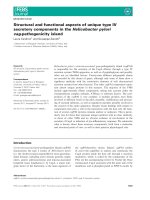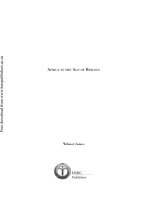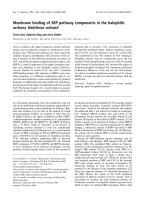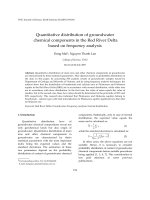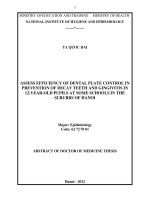long lifetime components in the decay of excited super heavy nuclei
Bạn đang xem bản rút gọn của tài liệu. Xem và tải ngay bản đầy đủ của tài liệu tại đây (575.79 KB, 5 trang )
EPJ Web of Conferences 63, 02011 (2013)
DOI:
10.1051/epjconf/ 20136302011
C Owned by the authors, published by EDP Sciences, 2013
Long lifetime components in the decay of excited super-heavy nuclei
M. Morjean1 , a , A. Chbihi1, M. Dasgupta2 , A. Drouart3 , J.D. Frankland1 , M.O. Frégeau1 , D.J. Hinde2 , D. Jacquet4 ,
L. Nalpas3 , M. Pârlog5 , C. Simenel2, L. Tassan-Got4 , and E. Williams2
1
GANIL, CEA-DSM and IN2P3-CNRS, B.P. 55027, F-14076 Caen Cedex, France
Department of Nuclear Physics, Research School of Physics and Engineering, The Australian National University, ACT 0200,
Australia
3
CEA-Saclay, IRFU/Service de Physique Nucléaire, F-91191 Gif sur Yvette Cedex, France
4
IPNO, CNRS/IN2P3, Université Paris-Sud 11, F-91406 Orsay Cedex, France
5
LPC, CNRS/IN2P3, ENSICAEN, Université de Caen, F-14050 Caen Cedex, France
2
Abstract. For nuclear reactions in which super-heavy nuclei can be formed, the essential difference between
the fusion process followed by fission and non-equilibrium processes leading to fission-like fragments is the
reaction time. Quite probable non-equilibrium processes, characterized by very short reaction times, are highlighted thanks to mass-angle correlations. However, long lifetime components associated with fission following
fusion have been observed with two independent experimental techniques, providing evidence for the formation
of compound nuclei with Z = 120 and 124, followed by mass asymmetric fission.
1 Introduction
In reactions between two very heavy nuclei, the tiny
cross-sections associated with evaporation residue detection makes it very difficult to demonstrate the formation by
fusion of super-heavy nuclei (atomic numbers Z > 110).
Even if compound nuclei are formed, they decay dominantly by fission, symmetric or possibly asymmetric in
mass. Therefore, experimental fusion cross-sections can
only be reached through fission fragment detection. However, the distinction between fusion followed by fission
(fusion-fission) and faster non-equilibrium processes (often called quasi-fission) is very tricky because the fission
fragments and fission-like fragments from quasi-fission
can be quite similar in mass, atomic number and energy
[1–3].
In most of the experimental work, the discrimination
between fusion-fission and quasi-fission reactions is somewhat arbitrary, based on considerations of the mass symmetry in the exit channel (ignoring thus any possible asymmetric fission) or the width of the mass and energy distributions. In fact, the objective difference between quasifission and fusion-fission is the reaction time [3–5]. After the fusion step, the nucleons are trapped within a potential pocket, and the composite system needs time to
find its way to scission. By contrast, in quasi-fission reactions the nucleons of the system are not trapped and a
very fast separation into two fission-like fragments takes
place. Therefore, the most reliable experimental criterion
that can be used to discriminate between fusion-fission and
quasi-fission reactions is the reaction time. In the followa e-mail:
ing, we shall first present recent reaction time measurements through mass-angular correlations, highlighting fast
processes leading to fission-like fragments in reactions between very heavy nuclei. We shall then present results
of experiments [5, 6] in which long lifetime components
(τ > 10−18 s) characteristic of fusion reactions were observed, associated with part of the reactions leading to
fission-like fragment production.
2 Reaction time from mass-angle
distributions
The correlation between the mass of the reaction products
and their emission angle can be used to highlight binary
reactions in which the sticking time is shorter or of the
same order as the rotational period of the composite system [3, 4]. For such fast reactions, the angular distributions measured as a function of the mass asymmetry in
the exit channel present maxima that can be linked to lifetimes of the composite system, assuming for each mass
asymmetry a single fast component in the reaction time
distribution. By contrast, for fusion-fission reactions associated with very long lifetimes, the composite system lives
much more than one rotational period and flat angular distributions are expected.
Mass-angle distributions for heavy systems have been
recently studied at the Heavy Ion Accelerator Facility at
the Australian National University. In these experiments
[4, 7], the two coincident fragments from binary reactions were measured by large area position sensitive multiwire proportional counters allowing the determination
of the detection angle and of the mass asymmetry in the
This is an Open Access article distributed under the terms of the Creative Commons Attribution License 2.0, which permits unrestricted use, distribution,
and reproduction in any medium, provided the original work is properly cited.
Article available at or />
EPJ Web of Conferences
exit channel. Figure 1 presents, for the heaviest system
presently studied at an energy above the Coulomb barrier, 48 Ti + 238 U at 289 MeV (E/B ∼ 1.1), the cross2
σ
section dθCMd ×dM
as a function of the center-of-mass scatR
tering angle θCM and of MR , the ratio of fragment mass
to compound nucleus mass. The minimum cross-sections
observed for symmetric splittings at any angle confirm
for this system the vanishing of symmetric fission already inferred from studies on lighter systems [3, 4, 7].
For mass asymmetric splittings, the angular distributions
clearly present maxima between 30 and 90◦ for MR < 0.5
(90 and 150◦ for MR > 0.5), indicating reactions lasting
less than the rotational period. Assuming reaction time
distributions with a single fast component, most probable reaction times treact
10−20 s can be inferred, even
for the longest quasi-fission reactions associated with the
largest deflection angles with respect to grazing trajectories. These quasi-fission times are in good agreement
with fully microscopic quantum calculations [8]. Nevertheless, it must be stressed that, for mass asymmetries
0.3 < MR < 0.4 (0.6
in addition to the fast component associated with quasifission reactions, long lifetime components characteristic
of fusion followed by asymmetric fission.
3 Long lifetime components
The reaction time treact
10−20 s inferred from the measured correlations between mass and angle for capture
reactions (either complete fusion followed by fission or
quasi-fission reactions) in the super-heavy nucleus domain
clearly demonstrates the presence of non equilibrium processes. However, it does not rule out longer reaction times
for a part of the events. Two different experimental techniques, which both present the advantage of being independent of any nuclear model, have been applied to detect
Figure 1. Correlation between the center-of-mass deflection angle (θCM ) and the mass ratio (MR ).
long lifetime components (τ > 10−18 s), characteristic of
fusion reactions: the blocking technique in single crystals
(section 3.1) and the X-ray fluorescence technique (section
3.2).
3.1 Long lifetime components from the blocking
technique in single crystals
Three different systems have been studied in reverse kinematics with the blocking technique [5]: 208 Pb + Ge at 6.2
MeV/u, 238 U + Ni at 6.6 MeV/u and 238 U + Ge at 6.1
MeV/u, possibly leading to compound nuclei with ZCN =
114 , 120 and 124, respectively. All the coincident charged
products were detected and identified by INDRA [9], a
highly efficient detector array covering a solid angle close
to 4π sr. In addition, the blocking patterns were measured for all the fragments detected around 20◦ . The reaction mechanism analysis performed with INDRA shows
that, for the two heaviest systems, the reactions are always binary when one of the fragments is detected with
70 Z 85 (only 2 fragments with Z > 6 in the exit channel). Furthermore, the sum of the atomic numbers of these
two heavy fragments is precisely equal to the total number
of protons in the system, as shown for example by figure 2
corresponding to the detection of a fission fragment with
70 Z 80 in the 238 U + Ni system. In addition, these
reactions are associated with negligible multiplicities of
lighter charged products (Z < 6). The detection of a fragment with 70 Z 85 provides thus us with an efficient
selection of capture reactions.
Thermal vibrations of the atoms of the single crystals
used as targets imply (see for example [10] and references
therein) that all reactions lasting less than about 10−18 s
lead to the same value of χmin , the relative yield of fragments detected in the precise direction of the crystal axes.
An increase of χmin for capture reactions is thus straightforward evidence for fusion-fission. For the two heaviest
Figure 2. Sum Z1 +Z2 of the atomic numbers of the two coincident fission-like fragments for 70 Z1 80.
02011-p.2
Heavy Ion Accelerator Symposium 2013
U + Ni @ 6.6 MeV/A → X-rays from Z = 120
238
64
dP / dE (keV -1)
Charge state 1+ (1 K-hole)
× 10
30
With broadening effects (electronic structures...)
-3
x 10
τnucl = 10-17s
Kα
2
20
Kα
1
10
Kβ
dP / dE (keV -1)
systems studied, a significant χmin increase (with respect to
the one measured for either deep-inelastic or quasi-elastic
reactions that gives us a reference for fast processes) was
observed for fission fragments with 70 Z 85, indicating the formation of compound nuclei with Z = 120 and
124. A minimum proportion of 10% of fusion-fission reactions was directly inferred from the χmin increase for the
detected fragments. By contrast, no long lifetime components could be evidenced for ZCN = 114, possibly due to
the compound nucleus neutron number being much lower
than the one usually predicted for the nearest shell closure
(N = 184).
× 10
160
170
180
190
200
3
220
230
τnucl = 10 s
-18
-3
x 10
8
210
6
4
× 10
160
170
180
190
200
210
220
230
τnucl = 10 s
-19
-3
0.4
x 10
0.3
0.2
0.1
-1
During a collision between two heavy ions, vacancies are
created in the inner electronic shells of the unified atom
[11, 12]. The vacancies are thereafter filled by transitions
of electrons from outer electronic shells, giving rise to Xray fluorescence (in the case of very heavy atoms, the fluorescence quantum yield can be accurately estimated as
1.0). Considering the independent lifetimes of the electron vacancies and of the compound nucleus, sizable probabilities of X-ray fluorescence from the unified atom can
only be observed when the compound nucleus lifetime is
at least of the same order of magnitude as the vacancy lifetime. Nuclear lifetimes of excited uranium nuclei have
been estimated with the fluorescence technique in good
agreement [13, 14] with those inferred from the blocking
technique in single crystals [15]. Since the lifetime of a vacancy in the K shell of a super-heavy atom is of the order
of 10−18 s [16], the multiplicity of XK rays with an energy
characteristic of the unified atom provides us with a sensitive probe for long lifetime components.
Unlike the blocking technique that requires good quality single crystals as targets, the X-ray fluorescence technique can be in principle applied to any combination of
projectile and target nuclei, giving thus access to investigations of a broader Z range. Furthermore, it makes possible
the use of isotopically enriched targets in order to study
the long lifetime component production as a function of
the compound nucleus isospin. However, this technique
had never been previously used in the super-heavy atom
domain. Therefore, the system 238 U + 64 Ni at 6.6 MeV/A,
leading to 302
120 X compound nuclei, has been chosen for a
first experiment [6], providing us both with a test of the
fluorescence technique and a cross-check with the crystal
blocking results.
The transitions from outer electronic shells to the
K shell of 302
120 X atoms have been calculated [17, 18]
with a multi-configuration-Dirac-Fock (MCDF) approach
[19, 20]. Only 3 main XK transitions are predicted, shown
in figure 3, yellow lines, for an ion with a charge 1+ for
different nuclear lifetimes (the lines are broadened by the
Weisskopf effect resulting from the finite nuclear lifetime
[21] and by the Doppler effect due to the experimental setup). For nuclear lifetimes associated with quasi-fission
reactions (τnucl ∼ 10−20 s) [3], the 3 lines are so broad
dP / dE (keV )
3.2 Long lifetime components from the X-ray
fluorescence technique
dP / dE (keV -1)
2
×10
160
10
170
180
190
200
180
190
200
-6
x 10
8
210
220
210
220
τnucl = 10 s
-20
230
6
4
2
0
160
170
230
E (keV)
Figure 3. Dominant XK lines for different nuclear lifetimes for
Z= 120 atoms in a charge state 1+ (yellow curves) and for a
more realistic electronic structure distribution (blue curves, see
text). The Doppler effect associated with the experimental set-up
described in section 3.2 is taken into account for the yellow and
blue curves.
that the very weak fluorescence yield only gives rise to
a continuous background. For longer nuclear lifetimes, 3
lines can still be observed, but the fluorescence probability is reduced by roughly a factor 30 between 10−17 s and
10−19 s. It must be stressed however that, in fusion reactions, the atoms are actually formed with broad distributions of charge states and electronic configurations giving
rise to slight shifts in the transition energies. Therefore,
the 3 lines possibly detected in coincidence with fission
fragments merge, even for the longest nuclear lifetimes
(figure 3, top), in a single peak at an energy around 190
keV, with a width of about 50 keV (blue lines in figure 3).
During the experiment, the fission fragments were
detected between 16◦ and 70◦ by telescopes (ionization
chambers followed by double-sided silicon strip detectors). Coincident photons were detected by 3 planar germanium detectors, operated under vacuum and covering a
solid angle Ω ≈ 0.8 sr . The 3 detectors were located at the
same polar angle (θ = 127◦), but at 3 different azimuthal
angles (φ = 30, 150 and 270◦ with respect to a vertical
plane perpendicular to the beam direction). The photon
energy spectrum measured by the germanium detector located at φ = 270◦ in coincidence with fission-like fragments (fragments detected with 35 Z 90) is presented
in the top left panel of figure 4 and in its bottom left panel
02011-p.3
Counts
EPJ Web of Conferences
64
U +30000
Ni 6.6 MeV/A
35 ≤ Z ≤ 90
Measured
25000
25000
Counts
Table 1. Multiplicity of photons with energy between 175 and
225 keV in coincidence with a fission fragment with atomic
number between Zmin and Zmax
238
30000
20000
20000
15000
15000
2000
Measured with 2000
background subtraction
1500
1500
1000
1000
500
500
0
0
-500
With random coincidence
correction
Zmin
35
. 50
70
80
With random coincidence
correction and
background subraction
Zmax
49
65
79
90
Multiplicity
0.064 ± 0.002
0.052 ± 0.002
0.102 ± 0.004
0.067 ± 0.004
by the random correction, as shown by the right panels of
figure 4, and the good suppression of the more probable
150 keV peak ensures that the 190 keV peak after random
correction corresponds to true coincidences with fissionlike fragments. Such fission-like fragments can arise either from quasi-fission reactions or from uranium fission
or from compound nucleus fission.
-500
150
200
250
E (keV)
150
200
250
E (keV)
Figure 4. Energy spectrum of photons in coincidence with fission fragments (upper left panel); Spectrum with background
subtraction (lower left panel) ; Spectrum with random coincidence correction(upper right panel); spectrum with random coincidences correction and background subtraction (lower right
panel)
after background subtraction. Two peaks are clearly seen
around 150 and 190 keV. The peak at 150 keV is precisely
located at the energy observed in singles measurements (as
well as at the energy observed in the random coincidence
spectra) for the 158.8 keV γ transition from the decay of
the first rotational band of uranium nuclei (the energy of
the γ-ray is shifted by the Doppler effect towards lower
energy due to the backward angle of the germanium detectors). After correction for random coincidences (right panels in figure 4), the 150 keV peak is strongly suppressed,
confirming the random aspect of these coincidences with
fission-like fragments. A peak at 200 keV, arising from
the 211 keV γ-transition of the same cascade decay as the
158.8 keV one, is also observed in the singles and random spectra. The broad peak observed in the left panel
of fig 3 around 190 keV contains therefore random coincidences with 200 keV γ-rays. However, the peak measured at 190 keV in coincidence with fission fragments is
much broader than the random ones at 150 and 200 keV
(Γ ∼ 50 keV for the 190 keV peak and Γ ∼ 8 keV for
the 200 keV one). Furthermore, since the 211 keV transition feeds the 158.8 keV one during the decay cascade, the
peak observed in single and random spectra at 200 keV is
much smaller than the one at 150 keV. Therefore, the probability measured for random coincidences with 200 keV
γ-rays is much smaller than the one with the 150keV γrays. Consequently the peak at 190 keV is not eliminated
The multiplicities of the 190 keV photons for different
bins in detected atomic numbers Z are presented in table 1.
The maximum multiplicity is reached for 70 Z 79.
Since this Z selection is only associated with capture reactions (see discussion in section 3.1 and figure 2), the coincident photons are emitted by the composite system or by
its fission(-like) fragments. Emission from a fission(-like)
fragment should be associated with significantly different
Doppler shifted energies measured at φ = 30 and 270◦
(δE ∼ 20 keV), whereas emission from the composite system should lead to identical energies, due to the symmetry
of the detection set-up with respect to the beam axis. The
energy spectra measured for 70 Z 85 at φ = 30 and
270◦ are presented in the upper part of figure 5. The difference of the two spectra (normalized to the surface of
the peak between 175 and 225 keV) is shown in the lower
part of the figure. No statistically significant difference
can be seen between the spectra which is a clear evidence
for emission from the composite system. Therefore, considering its energy and its width predicted by MCDF calculations, the peak at 190 keV must be associated to XK
fluorescence from Z=120 atoms.
The XK multiplicity MXK ∼ 0.1 measured for 70 Z
79 is very high. It is indeed of the same order than the Kvacancy creation probability that can be inferred [6] from
the one measured in coincidences with elastically scattered
projectiles, Pelast
∼ 0.27 (elastic scattering and fusion reK
actions correspond to similar atomic impact parameters).
Therefore, MXK can only be taken into account considering in the reaction time distribution sizable proportions of
long lifetime components with τ 10−18 s. Assuming an
exponential reaction time distribution, at least 50% of the
capture reactions associated with this Z bin would correspond to fusion-fission reactions. Considering the isotopically enriched target used for the X-ray fluorescence experiment, these conclusions are in good agreement with
the ones inferred from the blocking technique in single
crystals.
02011-p.4
Heavy Ion Accelerator Symposium 2013
References
0.1
0.09
238
64
U + Ni 6,6 MeV/A
70 ≤ Z ≤ 85
0.08
0.07
Φ = 30 deg
0.06
Counts
(normalized to the peak surface)
Φ = 270 deg
0.05
0.04
0.03
0.02
0.01
0
160
180
200
0.08
220
240
( Φ = 30 deg) - (Φ = 270 deg)
0.06
0.04
0.02
0
-0.02
-0.04
-0.06
-0.08
-0.1
160
180
200
220
240
E (keV)
Figure 5. Upper panel: Energy spectra, normalized to the area
of the peak between 175 and 225 keV, of photons detected at
φ = 30◦ (green) and 270◦ (blue). Lower panel: Difference of the
two spectra.
4 Conclusions
Reaction time measurements give access to unique pieces
of information on the reaction mechanisms involved between two very heavy ions at energies slightly above the
fusion barrier. Mass-angle correlations highlight fast nonequilibrium reactions and suggest a vanishing of the masssymmetric fission cross-section for the heaviest systems.
In a complementary approach, long lifetime components
observed for two very heavy systems testify to mass asymmetric fission following fusion. However, fusion has been
evidenced for these systems in experiments in which the
fission fragments were detected backward of the grazing
angle, whereas most of the cross-section associated with
capture reactions was located inside the grazing angle.
Therefore, experiments allowing the measurement of long
lifetime component probabilities over broad angular and
mass ranges are now highly desirable in order to determine
cross-sections for fusion as well as for non-equilibrium
processes.
[1] C. Lebrun, F. Hanappe, J.F. Lecolley, F. Lefebvres,
C. Ngô, J. Peter, B. Tamain, Nucl. Phys. A 321, 207
(1979)
[2] R. Bock, Y. Chu, M. Dakowski, A. Gobbi, E. Grosse,
A. Olmi, H. Sann, U. Schwalm et al., Nucl. Phys. A
388, 334 (1982)
[3] J. Toke, R. Bock, G. Dai, A. Gobbi, S. Gralla,
K. Hildenbrand, J. Kuzminski, W. Müller, A. Olmi,
H. Stelzer et al., Nucl. Phys. A 440, 327 (1985)
[4] R. du Rietz, D.J. Hinde, M. Dasgupta, R.G. Thomas,
L.R. Gasques, M. Evers, N. Lobanov, A. Wakhle,
Phys. Rev. Lett. 106, 052701 (2011)
[5] M. Morjean, D. Jacquet, J.L. Charvet, A. L’Hoir,
M. Laget, M. Parlog, A. Chbihi, M. Chevallier,
C. Cohen, D. Dauvergne et al., Phys. Rev. Lett. 101,
072701 (2008)
[6] M.O. Frégeau, D. Jacquet, M. Morjean, E. Bonnet,
A. Chbihi, J.D. Frankland, M.F. Rivet, L. TassanGot, F. Dechery, A. Drouart et al., Physical Review
Letters 108, 122701 (2012)
[7] D.J. Hinde, R. du Rietz, M. Dasgupta, EPJ Web of
Conferences 17, 04001 (2011)
[8] C. Simenel, Eur. Phys. J. A 48, 152 (2012)
[9] J. Pouthas et al., Nucl. Instr. Methods A 357, 418
(1995)
[10] D.S. Gemmel, Rev. Mod. Phys. 46, 129 (1974)
[11] W.E. Meyerhof, K. Taulbjerg, Ann. Rev. Nucl. and
Part. Sci. 27, 279 (1977)
[12] J. Reinhard, W. Greiner, J. Greenbergand, P. Vincent,
Treatise on Heavy-Ion Science, Vol. 5 (Plenum, New
York, 1985)
[13] J.D. Molitoris et al., Phys. Rev. Lett. 70, 537 (1993)
[14] H.W. Wilschut, V.L. Kravchuk, Nucl. Phys. A 734,
156 (2004)
[15] F. Goldenbaum et al., Phys. Rev. Lett. 82, 5012
(1999)
[16] T.A. Carlson, C.W. Nestor, At. Data and Nucl. Data
Tables 19, 153 (1977)
[17] M. Trassinelli, Private communication
[18] J.P. Desclaux, P. Indelicato, Mcdfgme, a
multiconfiguration dirac fock and general
matrix elements program,
release 2005,
/>[19] J. Desclaux, Comput. Phys. Commun. 9 (1975)
[20] P. Indelicato, Phys. Rev. A 42, 5139 (1990)
[21] V. Weisskopf, Phys. Zeit. 34, 1 (1933)
02011-p.5





